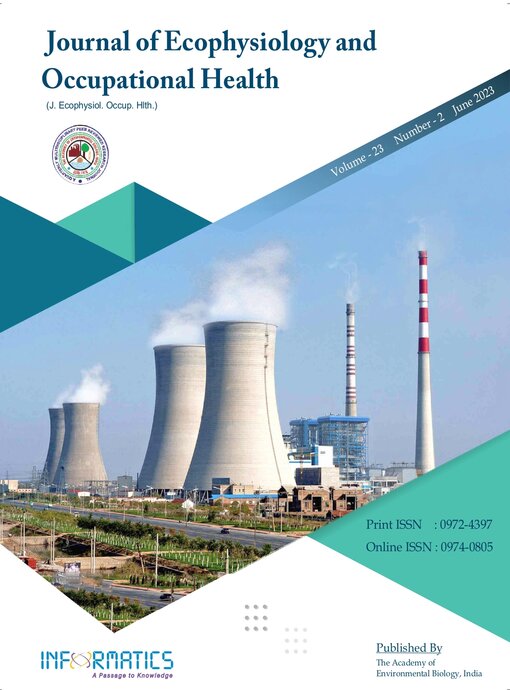Assessing the Change in Psychosocial Stress of Fireworks Workers of West Bengal During the Pre-Pandemic and During COVID-19 Pandemic
DOI:
https://doi.org/10.18311/jeoh/2023/33112Keywords:
COVID 19 Pandemic, Fireworks, Food Habit, Psychosocial Stress, Stressful Life EventsAbstract
The fireworks industries of South 24 Parganas, West Bengal, are centuries-old, unorganized cottage industries. The goal of the current study was to evaluate how psychosocial stress of fireworks workers of Bengal had changed during the COVID-19 pre-pandemic and during pandemic period, and to determine the underlying causes of it. 152 male fireworks workers of varying ages were chosen for this purpose. To measure the psychosocial stress of fireworks employees, the Job Content Questionnaire (JCQ) based on Karasek’s Demand-Control Model was used. A shortened Social Readjustment Rating Questionnaire (SRRQ- Holmes and Rahe, 1967) was followed to measure the life change value. The socioeconomic status related to psychosocial stress was also measured along with food habits. After analyzing psychosocial factors and outcomes, it was determined that financial condition and job stability of fireworks workers worsened notably during pandemic. There were prevalence of musculoskeletal disorders and lack of health awareness among them. Though, they were benefitted by different government schemes, low income and job stress led to increased psychosocial stress during the pandemic.
Downloads
Metrics
Downloads
Published
How to Cite
Issue
Section
License
Copyright (c) 2023 Payel Laskar, Subhadeep Ganguly, Zakir Md Hossain

This work is licensed under a Creative Commons Attribution 4.0 International License.
Accepted 2023-06-16
Published 2023-06-16
References
Cao X, Daniel QT, Xuelei Z and Chen W. Review on physicochemical properties of pollutants released from fireworks: Environmental and health effects and prevention. Environ Rev. 2017; 26(2). https://doi.org/10.1139/er-2017-0063 DOI: https://doi.org/10.1139/er-2017-0063
Doi Y. An epidemiologic review on occupational sleep research among Japanese workers. Ind Health. 2005, 43:3-10. https://doi. org/10.2486/indhealth.43.3 DOI: https://doi.org/10.2486/indhealth.43.3
International Labour Office (ILO). Psychosocial factors at work: Recognition and control. Occupational Safety and Health (Series No 56). Geneva: International Labour Office; 1986. ISBN/ ISSN922105411X
Eurofound and EU-OSHA. Psychosocial risks in Europe: Prevalence and strategies for prevention. Luxembourg: Publications Office of the European Union; 2014. Available at: https://osha.europa.eu/en/publications/reports/psychosocialrisks- eu-prevalence-strategies-prevention/view
EU-OSHA. New forms of contractual relationships and the implications for occupational safety and health. Luxembourg: Office for Official Publications of the European Communities; 2002. https:// osha.europa.eu/en/publications/report-new-forms-contractualrelationships- and-implications-occupational-safety-and-health
EU-OSHA. Expert forecast on emerging psychosocial risks related to occupational safety and health. Luxembourg: Office for Official Publications of the European Communities; 2007. https://osha. europa.eu/en/publications/report-expert-forecast-emergingpsychosocial- risks-related-occupational-safety-and-health-osh
Santoshi K, Kiran UV. Musculoskeletal disorders among rag pickers at Lucknow City. J Ecophysiol Occup Health. 2020; 20(3&4). https://doi.org/10.18311/jeoh/2020/25378 DOI: https://doi.org/10.18311/jeoh/2020/25378
EU-OSHA. The second European survey of enterprises on new and emerging risks (ESENER-2). Luxembourg: Publications office of the European Union; 2015. Available at: https://osha. europa.eu/en/tools-andpublications/publications/second-european- survey-enterprises-new-andemerging-risks-esener/view
Ishtiyaq A, Imtiaz A, Nafiaah N, Shahid. Novel Coronavirus (covid-19) a ubiquitous hazardto human health: A review. J Ecophysiol Occup. Health. 2020; 20(3&4). https://doi. org/10.18311/jeoh/2020/25381
Ahmad S, Hafeez A, Siddqui SA, Ahmad M, Mishra S. A review of COVID-19 (Coronavirus Disease-2019) diagnosis, treatments and prevention. Eurasian J Med Oncol. 2020; 4(2):116–25. https://dx.doi.org/10.14744/ejmo.2020.90853 DOI: https://doi.org/10.14744/ejmo.2020.90853
Kuorinka I, Johnson B, Kilbom A, Vinterberg H, Biering-Sørenson F, Andersson G, et al. Standardised Nordic questionnaires for the analysis of musculoskeletal symptoms. Appl Ergon. 1987; 18(3):233–7. https://doi.org/10.1016/0003-6870(87)90010-x DOI: https://doi.org/10.1016/0003-6870(87)90010-X
Cole TJ, Bellizzi MC, Flegal KM, Dietz WH. Establishing a standard definition for child overweight and obesity worldwide: International Survey. Br Med J. 2000; 320:1–6. https://doi. org/10.1136/bmj.320.7244.1240 DOI: https://doi.org/10.1136/bmj.320.7244.1240
Yaglou CP, Minard D. Control of heat casualties at military training centers. AMA Arch Ind Health. 1957; 16(4):302–16. PMID: 13457450
Fernandes AJ, Priyadarshini PN. A dynamic role of spiritual intelligence in job satisfaction at workplace. J Ecophysiol Occup Health. 2020; 22(3). https://doi.org/10.18311/jeoh/2022/30835 DOI: https://doi.org/10.18311/jeoh/2022/30835
Karasek R, Brisson C. The Job Content Questionnaire (JCQ): An instrument for internationally comparative assessments of psychosocial job characteristics. J Occup Health Psychol. 1998; 3(4):322–55. https://doi.org/10.1037//1076-8998.3.4.322 DOI: https://doi.org/10.1037/1076-8998.3.4.322
Preedy VR,Watson RR. Handbook of disease Burdens and Quality of Life Measures. 5-Point Likert Scale. Springer, New York, NY; 2020. https://doi.org/10.1007/978-0-387-78665-0_6363 DOI: https://doi.org/10.1007/978-0-387-78665-0_6363
Census of India. Provisional population table, Figures at glance, West Bengal; 2011.
Chakrabarti D. Indian anrthropometric dimension for ergonomics design practice. National Institute of Design. 1997:34. https:// www.researchgate.net/publication/273766493_
Gangopadhyay PK, Saha T, Ghosh R. Occupational health problems of stone crusher in West Bengal – A pilot study at Birbhum District. Regional Occupational Health Centre (E). 2004:2–9.
Gangopadhyay PK, Mukherjee AK, Chattopadhyay BP, Pradhan CK, Munda DS, Dalal B, et al. Evaluation of occupational health problems of cycle rickshaw pullers and redesign of cycle rickshaw on ergonomics principle. Min. Hlth and family Welfare, GOI. Regional Occupational Health Centre (E). 2009:21–30.
Laskar P, Ganguly S, Md Hossain Z. Ergonomic risk factors and work-related musculoskeletal disorders among fireworks workers in West Bengal, India: A cross-sectional study. bioRxiv preprint; 2021. https://doi.org/10.1101/2021.06.07.447321 DOI: https://doi.org/10.1101/2021.06.07.447237
Torres SJ, Nowson CA. Relationship between stress, eating behavior, and obesity. Nutrition. 2007; 23(11-12):887–94. https:// doi.org/10.1016/j.nut.2007.08.008 DOI: https://doi.org/10.1016/j.nut.2007.08.008
 Payel Laskar
Payel Laskar








